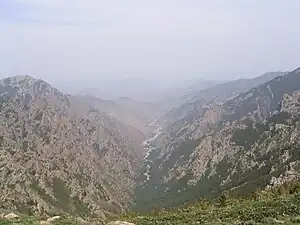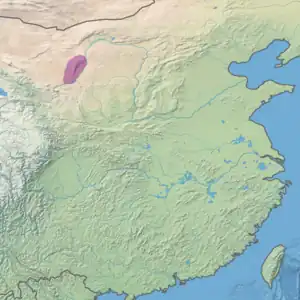| Ecoregion: Helanshan montane conifer forests | |
|---|---|
 Valley in Helan Mountains | |
 Ecoregion territory (in purple) | |
| Ecology | |
| Realm | Palearctic |
| Biome | temperate coniferous forests |
| Geography | |
| Area | 24,605 km2 (9,500 sq mi) |
| Countries | China |
| Coordinates | 38°54′N 105°58′E / 38.900°N 105.967°E |
The Helanshan montane conifer forests ecoregion (WWF ID: PA0508) covers an isolated, forested mountain range surrounded by desert and semi-arid basins. As such, it has been called a "mountain island in the sky", and supports endemic species of plants and animals.[1][2] The region supports the endangered Helan Shan pika.
Location and description
The Helan Mountains ecoregions lies to the east of the Alashan Plateau semi-desert ecoregion, and to the west of the Ordos plateau steppe ecoregion. It is thus surrounded by arid basins. The mountain range is 180 km long, and reaches a peak altitude of 3,556 meters. The lower valleys between ridges are less forested.
Climate
The climate of the ecoregion is cold semi-arid (Köppen climate classification (BSk)). This climate is generally characterized as a 'steppe' climate, with precipitation greater than a true desert, and also a colder temperature.[3][4]
Flora and fauna
Within the ecoregion, tree cover depends on the altitude zone. The lower slopes of the mountains are semi-arid, supporting short Siberian elm (Ulmus pumila) trees near intermittent streams. The valleys also support stands of Chinese red pine (Pinus tabuliformis). Higher on the hillsides are drought-adapted shrubs of rose, elm, caranga, ostryopsis (a type of birch tree), and juniper. At the highest elevations, tree cover is mostly dragon spruce (Picea asperata), birch and poplar.[1]
References
- 1 2 "Helanshan montane conifer forests". World Wildlife Federation (WWF). Retrieved November 28, 2019.
- ↑ "Map of Ecoregions 2017". Resolve, using WWF data. Retrieved September 14, 2019.
- ↑ Kottek, M., J. Grieser, C. Beck, B. Rudolf, and F. Rubel, 2006. "World Map of Koppen-Geiger Climate Classification Updated" (PDF). Gebrüder Borntraeger 2006. Retrieved September 14, 2019.
{{cite web}}: CS1 maint: multiple names: authors list (link) CS1 maint: numeric names: authors list (link) - ↑ "Dataset - Koppen climate classifications". World Bank. Retrieved September 14, 2019.